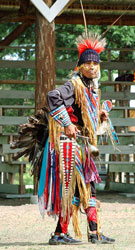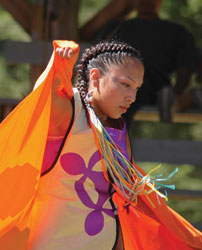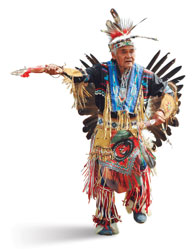The Riotous Beauty of the Ancient Dances
 |
|
Edward Dick, the son of Johnny Johnson, is a Chicken Dancer – a physically demanding dance. “Chicken” refers to the Prairie Grouse, and the dance comes from ceremonial dances in which the Blackfoot, Shoshone, Sioux and Cheyenne imitated the courtship displays of the Prairie Grouse. In the past it was a sacred dance and there are some that wish to return it to sacred status. |
By Photos by Liz Twan
From far away, you can hear the pounding of the drum and the haunting echo of the song urging you to join in the dance. Welcome to the powwow – a gathering of North American Native people. This is a colourful cultural celebration of dancing, drumming and singing; a gathering to visit with old friends and make new ones.
The origin of the powwow is unclear. History credits the Ponca (Southern Plains tribes) war dance societies, while others surmise that it began when the U.S. government pushed First Nations peoples onto reserves, then forcing the Natives to entertain the white public through dance. The word itself may come from the Pawnee word pa-wa – meaning “to eat” or maybe the Algonquin word pauau – a gathering of people for an important event, a celebration.
Around the turn of the last century, governments forbade Native dancing, fearing that all were war dances. After the 1920s, the fear faded and the people were again permitted to dance and celebrate their cultural and spiritual beliefs. This is also when dancing became inter-tribal and contest dancing began.
Today powwows can be traditional – a social gathering or memorial – or a contest where dancers, singers and drummers compete for prize money. The all-out effort given by the participants in a contest makes for lively viewing for a rookie spectator.
A circle, symbolic of the life cycle is all-important in Native American culture and is reflected in the structure of the gathering. At a powwow, the dancers are in the center of the circle (the arena), the drums and the audience circle the dancers, the vendors and the rest of the encampment encircle them. The most important part of the arena is the drum, which includes both the instrument and the singers. The host drum, or head drum (responsible for the songs) is placed in a central location, a place of respect.
 |
|
Valerie Johnson of the Esketemc First Nation appears to float like a colourful butterfly in her vibrant orange and purple regalia. She was dancing at the mid-August Esketemc Traditional Powwow hosted by the Esketemc Youth for Sobriety Group. The powwow arbour at Alkali Lake is located in a beautiful remote forested place near a lake, quite far from the main reserve. Valerie dances in the Women’s Fancy Shawl category and she was chosen to be the Powwow Princess on this day. |
Like any other big event, powwows are organized and planned by a hard-working committee. A master of ceremonies sets the tempo of the event and decides the order of the dances. They know the rules and etiquette, keep the public informed and provide interesting commentary during lulls. There is a friendly informal competition on the powwow trail to see who can be the most entertaining M.C. The “colours” are usually posted at or near the M.C.’s table, front and center – they often include the U.S., Canadian or Mexican flags, an eagle staff, and perhaps a military flag (veterans are held in tremendous honour). The eagle staff – a curved, six-foot long staff with eagle feathers attached serves as the flag for Native Americans and it is displayed more prominently.
The arena director (or whip man) is the keeper of the circle; making sure that the dance area is clean and safe, that any disruptive influences are removed from the area and it is he who picks up any item (considered a mistake) dropped by a dancer. He is also responsible for keeping track of the dancers, the singers and drummers and special events.
The songs have been learned from elders, or are original compositions – many drum g
 |
|
Johnny Johnson of the Esketemc First Nation is a pensioner who dances with the strength and vitality of a man in his forties. Johnny’s dancing/drumming/singing has taken him as far east as Buffalo, N.Y. and as far north as Alaska. Johnny is a healer and a believer in the old way of the Medicine Wheel. |
roups have produced CDs of their music. Many songs are sung in the singers native language, some are in English while others are sung in “vocables” – a set of syllables – so that any singer from any tribe can sing along. Most people seated at the drum, sing and drum and have a huge repertoire of songs – flag, memorial, veteran, contest and intertribal are but a few examples.
Princesses are important figures – usually girls from ages 15-20, who are elected annually or selected from a contest at each powwow.
Each powwow begins with the Grand Entry. Often the eagle staff is carried in first, then the Canadian and American flags, province, state and tribal flags. Entering after the flag carriers are the Princess’ invited dignitaries, then the men (traditional dancers first, grass and fancy dancers next) followed by the women dancers (traditional, fancy shawl and jingle dress), then junior boys and junior girls (same order as adult dancers), then the tiny tots, boys and girls. The group moves clockwise (sunwise) around the circle showing their regalia and dance steps.
 |
|
19-year old Blaine Abraham, a Chicken Dancer from Lake Babine Nation, Burns Lake, B.C. |
At the conclusion of the grand entry there is a flag song and an honour song, then an invocation (usually by a respected elder) blessing the gathering. The eagle staff is then usually tied to a pole at the center of the arbor or kept at the announcer’s stand. It is always at a higher level than the flag.
Then the dancing begins. In contest dances, only registered contestants dance. In an intertribal anyone can dance, even a tourist in street clothes. The participants are from all walks of life and from many tribes in North America. All are beautiful in their splendid attire. Certain people, however, stand out from the crowd.
72-year-old Evelyn (Eagle Speaker) Locker is one of those people. Impeccably groomed and clothed with heavy, white buckskin covered in thousands of orange, red and black glass beads, she was the picture of calm in a sea of noise and riotous colour. Her jet-black cowboy hat carried a heavily beaded crown that read ‘Calgary Stampede Queen 1954,’ the first ever Native woman to win that crown.
 |
|
Garrett Mountain Chief III of the Nlaka’Pamux First Nation (Thompson Band), B.C. dances at the Cariboo Contest Powwow in Williams Lake, B.C. Garrett travels with his mother, Wenona Mike, grandmother Vivian Narcisse and the rest of his fellow-family dancers, grandfather Arnie Narcisse, his uncle and two aunts, Montana, Gail and Andrea Mountain Chief – three generations together on the powwow trail. |
Evelyn was raised on the Blood Reserve near Cardston and after graduating from Business College she began working for the City of Calgary. In 1954 at the age of 19 she was approached by the Elks Lodge and asked to run in the Calgary Stampede Queen contest. At first she declined, and then she decided to let her name stand. Not for personal glory, but to bring attention to her people to show that they were capable of being anything they chose to be.
“I wanted to be an example to the youth of my nation and a symbol for the wider world that the Indian of today could be well educated and a good Canadian,” Evelyn said. “To show that Native people could compete equally in such a contest.”
Evelyn didn’t need to win the contest to be royalty. She is the daughter of Chief Eagle Speaker and a natural born princess of the Blood tribe. Princess Wapiti (Evelyn) was further honoured just prior to the Calgary Stampede when she was named an honourary princess for the five Southern Alberta tribes. Never before had the five chiefs bestowed such an honour. The five eagle feathers that Evelyn wore in her headband thereafter symbolized her adoption by the five tribes.
 |
|
17-year-old Janelle Alphonse competing in Teenage Fancy Shawl at the Cariboo Contest Powwow. Janelle’s father is the Chief of the Williams Lake Indian Band. |
Back then, the Calgary Stampede Queen contest was decided by ticket sales and months of appearances paid off in a landslide win for young Evelyn Eagle Speaker. The exciting year that followed included a trip to both Las Vegas and Los Angeles where Evelyn met movie stars including Jane Powell (Seven Brides for Seven Brothers) and John Derek (The Ten Commandments).
Now retired and living with her husband of 50 years, Bob Locker, in Surrey, B.C., the couple travels across the province attending powwows, including the July Powwow held on the Blood Reserve in Alberta. Bob is the support crew, driving their motor home and providing moral support. Evelyn is aware of her status as a dancer, as an elder, and as one of the few people adopted by the Five Tribes. She is a woman of extraordinary grace and calm.
In the searing heat on the Williams Lake weekend Evelyn serenely waits for the song to commence – then she begins to dance.
Powwow Etiquette
Do bring a lawn chair, sometimes seating is limited (concessions are usually available)
Do not bring alcohol or drugs
Do bring children, but keep a close eye on them
Do bring a camera, but ask permission to use it (M.C.)
Do listen carefully to the M.C. (lets you know what to do)
Do stand (men remove hats) for the Grand Entry, Honour Song, etc.
Do behave with respect (no talking during speeches, prayers, etc.)
Do not sit in places where someone’s personal belongings already are
Do not pick up anything a dancer drops (point it out to someone)
Do donate money to the powwow (during a blanket dance)
Do remember that you are a guest and act accordingly
Do enjoy yourself
 |
|
Glen Michell is a 35-year-old single father from Lytton, B.C. His devotion to his sons shines through as his regalia features their names in beads – Joe and Eric – as well as their beaded handprints on each of his shoulders.The Grass Dance – originally a warrior society dance, is now a very competitive dance for men. The “grass” comes from some northern tribes old custom of wearing braided grass in their belts. Today, the grass is symbolized by a fringe of yarn or ribbon. |
Powwows are held throughout the nation and everyone is welcome. Some charge admission. The participants’ ages range from infants carried by a parent to grandparents of advanced age. Dancing keeps them young at heart.
Powwows are happy places with the emphasis on preserving traditions, culture and family, so when you attend, leave the bad stuff behind. Clean and sober guests are welcomed. The dancing often begins at midday and goes on into the late evening. Most powwows begin the Friday evening and end late afternoon on Sunday.
Western Canadian Powwows and Dance Exhibitions Grouard Powwow, Northern Lakes College
April 28, Grouard, Alta.
Lil’Wat Celebrations Powwow
May 1 – 3, Mt. Currie, B.C.
Cedar Cottage Powwow
May 11 – 13, Vancouver, B.C.
Henry Shingoose Traditional Powwow June 2 – 3, Selkirk, Man.
Head-Smashed-In Interpretive Centre – Drum and Dance
July & August, every Wednesday, Fort Macleod, Alta.
Indian Village, Calgary Exhibition
and Stampede
July 6 – 15, Calgary Alta.
Squilax Powwow
July 20 – 22, Chase, B.C.
Head-Smashed-In Interpretive Centre July 23, Fort Macleod, Alta.
Squamish Nation Powwow
August 1 – 3, North Vancouver, B.C.
Kamloopa Powwow
August 1 – 3, Kamloops, B.C.
Long Plain First Nation Tribal Days & Powwow
August 3 – 5, Long Plain, Man.
Bonaparte Traditional Powwow
August 10 – 12, Historic Hat Creek Ranch, B.C.
Standing Buffalo Contest Powwow
August 10 – 12, Fort Qu-appelle, SK
Kehewin Contest Powwow
August 17 – 19, Kehewin, Alta. Long Lake Rodeo Grounds
Fraser Valley Contest Powwow
August 24 – 26, Fort Langley, B.C.
Cariboo Contest Powwow
August 31 – September 2, Williams Lake,B.C.
Semihoo Powwow
September 15 – 16, White Rock, B.C.
Thanksgiving Powwow
October 5 – 7, Mt. Currie, B.C.
Manito Ahbee Aboriginal Festival for all Nations, International Competition Powwow
November 1– 4, Winnipeg, Man.
Remembrance Day Powwow
November 9 – 11, Lytton, B.C.
NAAW Powwow
November 23 – 25, Squamish, B.C.
For more information, visit
msnusers.com/PowWowBC
www.drumhop.com
www.albertaaboriginaltourism.com
Liz Twan lives with her husband, Bronc and two sons, Willee and Jesse on the Alkali Lake Ranch, her home for 28 years now. With her pen and her camera, she records ranch life and local history for those who will come later.














